SUBFAMILY AMBLYOPONINAE
Genera Stigmatomma Roger and Xymmer Santschi
| The Ants of
Africa SUBFAMILY AMBLYOPONINAE Genera Stigmatomma Roger and Xymmer Santschi |
|
| Contents - Amblyoponinae - Subfamily Amblyoponinae |
In Tribe AMBLYOPONINI.
Diagnostic Features - Elongated mandibles, pointed at the apex, but not as long as the head, and the tooth row on the inner margin single. Finely sculptured.
Erichson (1842: 260, type species Amblyopone australis, type
location Australia); senior synonym of Stigmatomma by Emery
& Forel (1879: 455) and its subgenus Xymmer Santschi
(1914d: 311), raised to genus in Wheeler (1922: 641), synonymy by Brown
(1949c: 87). Erichson's (1842) description (drawing unavailable) is at ![]() .
.
Santschi's (1914d) defintion of Stigmatomma (Xymmer), type species S. (X) muticum - essentially was "Clypeus advanced in a rectangular lobe; mandibles narrow with a range of simple teeth along the internal border; alitrunk narrow with the promesonotal suture distinct, the metanotal suture obsolete; petiole narrow, and elongated in frony, gaster strangled and very long; the rest as for Stigmatomma".
Although Brown (1949c) synonymised Xymmer with Stigmatomma, it is noteworthy that in his review (1960a) he wrote of Amblyopone as having the - "petiole with little or no peduncle"; otherwise he gives no more than a listing of African species.
A primarily savannah genus, described by Bolton (1973a) as rare and little known in West Africa. Arising from the ant ecology investigations at Lamto (Ivory Coast), Brown, Gotwald & Lévieux (1971) wrote how five or six members of the genus, together with Apomyrma stygia, constituted a remarkable and unexpected cryptic soil fauna, with some, perhaps all, feeding on centipedes. Gotwald and Lévieux (1972) described a new species, providing information on its biology, and wrote of "at least four species, Amblyopone mutica, Amblyopone pluto and 2 or 3 other species related to Amblyopone normandi and Amblyopone santschii being found at Lamto". Lévieux (1983b) described the members as subterranean inhabitors of savannah, which feed on geophilid centipedes (see Hölldobler & Wilson, 1990, page 559). The name Amblyopone stygia, is listed in Hölldobler & Wilson (1990, page 559) but this surely is Apomyrma stygia, the only Ponerine species with that specific name. From Bolton (1995) only three species have type locations in West Africa, but three others Amblyopone emeryi, Amblyopone gaetulica and Amblyopone normandi have type locations in North Africa.
Key to Sub-Saharan species. This has changed with the paper by Yoshimura & Fisher
(2012). They revive the monotypic Xymmer and Stigmatomma but gave no key to separate the workers.
| 1 | 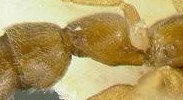 Clypeus with unarmed
anterior margin (a plate-like projection); petiole ventrally with only a low tubercle, with a
distinct narrow peduncle and a narrowed junction with the gaster; head
strongly narrowed posteriorly in full-face view; mandibles elongated; generally slender Clypeus with unarmed
anterior margin (a plate-like projection); petiole ventrally with only a low tubercle, with a
distinct narrow peduncle and a narrowed junction with the gaster; head
strongly narrowed posteriorly in full-face view; mandibles elongated; generally slender |
Xymmer - 2 |
| -- | 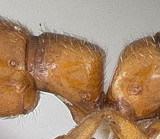 Clypeus with dent-like or peg-like projections on the anterior
margin; petiole ventrally with a distinct anterior process, no
obvious peduncle and more or less broadly attached to the gaster; head
rectangular or nearly so in full-face view only weakly narowed
posteriorly or not narrowed; mandibles variable; generally stockier Clypeus with dent-like or peg-like projections on the anterior
margin; petiole ventrally with a distinct anterior process, no
obvious peduncle and more or less broadly attached to the gaster; head
rectangular or nearly so in full-face view only weakly narowed
posteriorly or not narrowed; mandibles variable; generally stockier |
Stigmatomma - 3 |
| 2 |  TL 3.5 (including mandibles); petiole in dorsal view an
elongated oval; mandible with 10-11 fine teeth; generally yellow-brown TL 3.5 (including mandibles); petiole in dorsal view an
elongated oval; mandible with 10-11 fine teeth; generally yellow-brown |
West Africa - Xymmer muticus |
| -- | 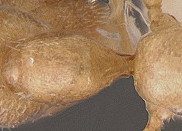 Petiole in dorsal view near rectangular; mandible with
five coarse teeth; note - the specimen is a queen; generally lacking in
colour Petiole in dorsal view near rectangular; mandible with
five coarse teeth; note - the specimen is a queen; generally lacking in
colour |
Nigeria specimen |
| 3 | 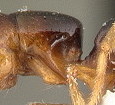 Petiole ventrally with a low process and attachment to
gaster almost as deep as first gastral segment Petiole ventrally with a low process and attachment to
gaster almost as deep as first gastral segment |
4 |
| -- |  Petiole ventrally with a well developed process and
attachment to gaster not as deep as first gastral segment Petiole ventrally with a well developed process and
attachment to gaster not as deep as first gastral segment |
5 |
| 4 |  TL 5.7-6.4 mm; head rectangular in full-face view;
mandibles relatively short and sub-triangular; shiny appearance and
head with spaced out punctures; anterior margin of clypeus with a row
of peg-like teeth; mainly dark brown and shiny, extremities and
appendages progressively lighter TL 5.7-6.4 mm; head rectangular in full-face view;
mandibles relatively short and sub-triangular; shiny appearance and
head with spaced out punctures; anterior margin of clypeus with a row
of peg-like teeth; mainly dark brown and shiny, extremities and
appendages progressively lighter |
Ivory Coast - Stigmatomma pluto |
| -- | 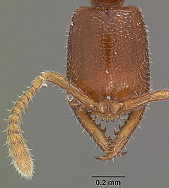 TL < 2.5 mm; head slightly narrowed posteriorly in
full-face view; mandibles elongated and narrow; anterior clypeal margin
with six strongly developed and quite sharp teeth; alitrunk in dorsal
view narrow and elongated, propodeum sides straight after metanotum TL < 2.5 mm; head slightly narrowed posteriorly in
full-face view; mandibles elongated and narrow; anterior clypeal margin
with six strongly developed and quite sharp teeth; alitrunk in dorsal
view narrow and elongated, propodeum sides straight after metanotum |
Kenya specimen |
| 5 | 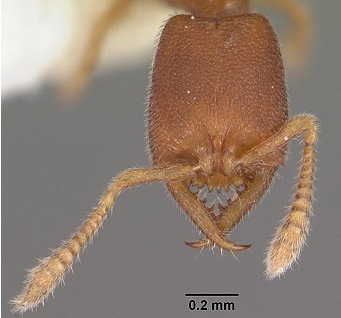 TL 4 mm; petiole in profile with a relatively narrow
attachment to gaster with vertical anterior margin to gaster in
profile; anterior margin of clypeus with well developed blunt teeth TL 4 mm; petiole in profile with a relatively narrow
attachment to gaster with vertical anterior margin to gaster in
profile; anterior margin of clypeus with well developed blunt teeth |
West Africa - Stigmatomma santschii |
| -- | Petiole in profile with attachment to gaster as wide as first gastral segment; generally stocky | 6 |
| 6 | 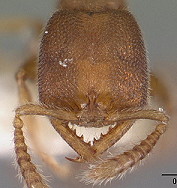 TL ca 1.5 mm; head near square in full-face view; anterior
margin of clypeus near smooth and slightly convex; mandibles striate;
propodeum in dorsal view near square with a straight posterior margin;
sculpturation other than on head much reduced giving shiny appearance
to alitrunk, petiole and gaster; head quite coarsely punctate TL ca 1.5 mm; head near square in full-face view; anterior
margin of clypeus near smooth and slightly convex; mandibles striate;
propodeum in dorsal view near square with a straight posterior margin;
sculpturation other than on head much reduced giving shiny appearance
to alitrunk, petiole and gaster; head quite coarsely punctate |
Rwanda specimen |
| -- | Anterior clypeal margin with distinct teeth | 7 |
| 7 |  TL ca 3 mm; anterior clypeal margin with poorly developed
teeth; in dorsal view propodeum with convex margins and strongly
widened posteriorly; sculpturation other than on head much reduced
giving shiny appearance to alitrunk, petiole and gaster TL ca 3 mm; anterior clypeal margin with poorly developed
teeth; in dorsal view propodeum with convex margins and strongly
widened posteriorly; sculpturation other than on head much reduced
giving shiny appearance to alitrunk, petiole and gaster |
Cameroun specimen |
| -- | 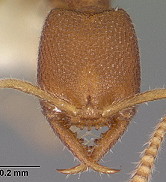 TL ca 1.6 mm; anterior clypeal margin with peg-like
central tooth and lateral semi-double peg-like teeth; propodeum in
dorsal view slightly longer than wide, posterior margin sinuous;
general sculpturation a dense reticulo-puncturation TL ca 1.6 mm; anterior clypeal margin with peg-like
central tooth and lateral semi-double peg-like teeth; propodeum in
dorsal view slightly longer than wide, posterior margin sinuous;
general sculpturation a dense reticulo-puncturation |
Ghana specimen |
|
© 2007, 2008, 2010, 2012 - Brian Taylor CBiol FSB FRES 11, Grazingfield, Wilford, Nottingham, NG11 7FN, U.K. |
href="amblyopone.htm"